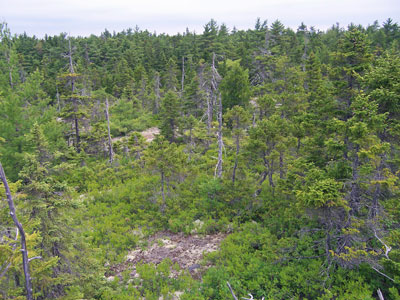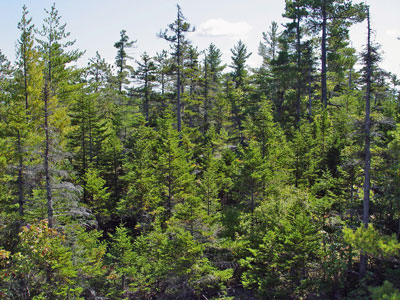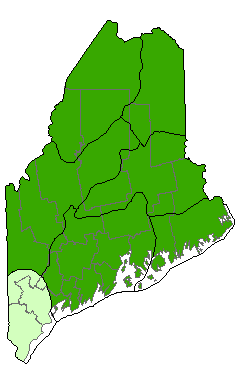DACF Home → Bureaus & Programs → Maine Natural Areas Program → Communities, Plants, and Animals → Natural Community Fact Sheets → Spruce - Pine Woodland
Printer Friendly Fact Sheet - 1.1 MB pdf (Get a free copy of Adobe Acrobat Reader)
Spruce - Pine Woodland
Scientific Name: Red Spruce - Mixed Conifer Woodland; State Rank: S4

- Community Description
- Soil and Site Characteristics
- Diagnostics
- Similar Types
- Conservation, Wildlife and Management Considerations
- Distribution
- Characteristic Plants
- Associated Rare Plants
- Associated Rare Animals
- Examples on Conservation Lands You Can Visit
Community Description: This type is a mixed canopy woodland (25-70% closure) in which red spruce and/or white pine is always present and associated species vary. Red spruce or white pine is strongly dominant at some sites; at others, the canopy is mixed, with no one tree species strongly dominant. White spruce may rarely replace red spruce at coastal sites. The shrub layer is typically very sparse (and variable in composition), and the herb layer has mostly 15-50% cover. Heath shrubs are the dominant feature of the herb layer; herb species rarely exceed 8% cover. The bryoid layer is sparse at some sites (<25%) and well developed at others (35-70%). Fruticose lichens typically make up half or more of the bryoid cover. Back to top.

Soil and Site Characteristics: Sites occur on mid to upper slopes (usually 10-20% slope) and low summits at elevations up to 2000'. Soils are thin (<25 cm), consisting of coarse mineral soil or poorly decomposed duff, and form patches over the bedrock substrate. The very well drained soils are acidic (pH 4.6-5.2) and nutrient poor. Some sites show evidence of past fire and are not open 'balds', but many do not. Back to top.
Diagnostics: Sites are woodlands on bedrock with conifer cover exceeding deciduous cover. Red spruce is typically dominant or occasionally co-dominant with white pine or red spruce. Back to top.
Similar Types: Other upland coniferous woodlands may include red spruce but will have other tree species (northern white cedar, pitch pine, red pine, jack pine, or black spruce) in greater abundance. Oak - Pine Woodlands may have considerable red spruce (an oak - spruce mix), but have more deciduous than coniferous tree cover. Moving downslope, or into areas of greater soil development, these woodlands can grade into spruce or pine forests, but those have more continuous canopy and less shrub and herb cover. Back to top.
Conservation, Wildlife and Management Considerations: Most sites have little pressure from development or timbering; the primary impacts are from recreational use. Communications towers or wind turbines could have an impact on some of these woodlands on mid-elevation summits. Several sites are in public or private conservation ownership.
Birds that may nest in this habitat include the sharp-shinned hawk, gray jay, yellow-bellied flycatcher, boreal chickadee, blackburnian warbler, red crossbill, and northern parula. Back to top.
Distribution: New England - Adirondack Province and Laurentian Mixed Forest Province, extending eastward, westward, and northward from Maine. Landscape Pattern: Small Patch. Back to top.


Characteristic Plants: These plants are frequently found in this community type. Those with an asterisk are often diagnostic of this community.
- Canopy
- Balsam fir*
- Black spruce*
- Northern white cedar*
- Paper birch*
- Red spruce*
- White pine*
- White spruce*
- Sapling/Shrub
- Bayberry*
- Shadbush
- Wild-raisin*
- Dwarf Shrub
- Black huckleberry*
- Lowbush blueberry*
- Sheep laurel*
- Herb
- Bracken fern
- Bryoid
- Dicranummoss
- Red-stemmed moss
- Reindeer lichen*
There are no documented rare plants associated with this natural community.
There are no documented rare animals associated with this natural community.
Examples on Conservation Lands You Can Visit
| Example | County |
|---|---|
| Holbrook Island Sanctuary State Park | Hancock Co. |
| Mahoosuc Mountain, Mahoosuc Public Lands | Oxford Co. |
| Mansell Mountain, Acadia National Park | Hancock Co. |
| Nahmakanta Public Lands | Piscataquis Co. |
| Petit Manan Point, Petit Manan National Wildlife Refuge | Washington Co. |